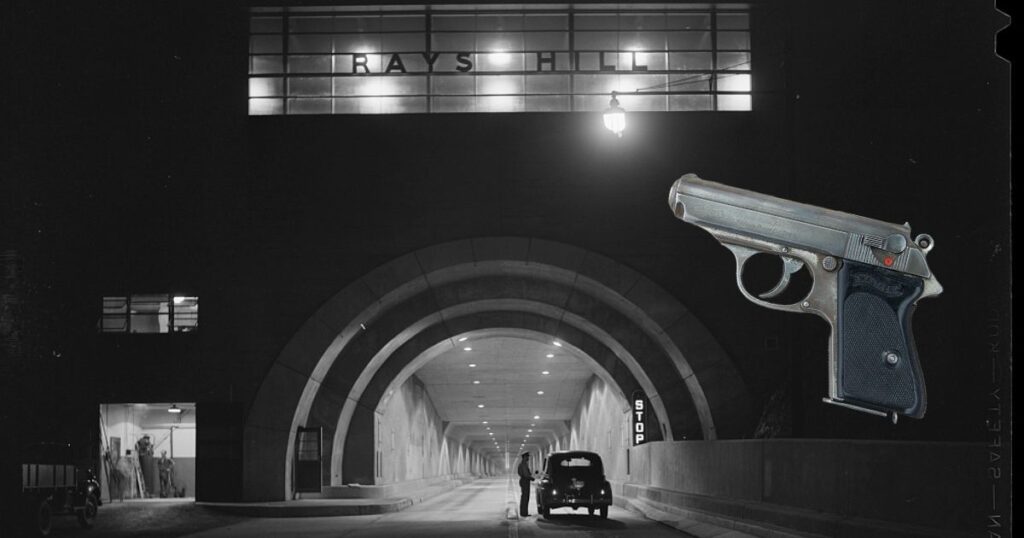About 4 pm on July 25, 1953, Lester Woodward, a 30-year-old truck driver, was found shot to death in the cab of his car carrier parked beside the Pennsylvania Turnpike about a mile west of the Irwin Interchange. His empty wallet was found on the floor of the cab.
Police theorized Woodward had pulled over to take a nap and may have been killed in his sleep. He was shot in the left temple. The bullet took a downward course and lodged near his jugular vein.
It appeared to be a senseless and random crime with robbery as the motive.
Three days later, on July 28, the body of Harry Pitts, a 39-year-old trucker from Bowling Green, VA, was found in his parked truck near the Donegal interchange, 30 miles from where Woodward was killed. Pitts had not been robbed, and police theorized that something frightened the killer away.
The next day, ballistics tests confirmed both men were killed by the same .32-caliber automatic.
State Police Corporal William Smith told a United Press (UP) reporter, “There’s a maniac loose on the turnpike.”
The manhunt for a phantom killer was on.
Then on July 31, John Shepard, a 36-year-old truck driver, was shot in the head and robbed in his truck near Lisbon, OH, eighteen miles from the western end of the Pennsylvania Turnpike.
The bullet took a downward course from his temple, missed his brain by a fraction of an inch, and lodged in Shepard’s jaw. He survived and said he saw a yellow Chevy drive away. His wallet and pocket watch were stolen.
The Pennsylvania Turnpike, a toll road, was America’s first superhighway. The highway crosses the Appalachian Mountains in central Pennsylvania, passing through four tunnels. Sometimes called the “dream highway,” it originally had no speed limits, except in the tunnels. In 1953, it went from Philadelphia to the Ohio State Line.
August 3 came and went without an appearance by the phantom killer. Police increased patrols on the turnpike and frantically followed up on every lead that came their way, no matter how slight.
Newspapers referred to the shooter as the Turnpike Phantom, the Phantom Killer, or the Terror of the Turnpike. The Teamsters Union, the Pennsylvania Motor Truck Association, and a trucking company placed an $11,000 bounty on the killer’s head.
Truck drivers began carrying baseball bats or guns. Local police departments reported a flood of gun permit requests from drivers, but these were refused on the theory that it would just make a bad situation worse.
Some theorized that the killer was motivated by a grudge, and the police began sifting through reports of fatal accidents involving trucks.
Paranoid drivers started reporting they were being followed. Trucker Charles Watts reported being “shadowed” for 17 miles by a suspicious Chevy station wagon.
Another driver reported being shot at while he drove down the highway. Police could find no bullet holes in the truck and decided the driver might have mistaken backfires for gunshots.
Drivers began parking at service stations and all-night diners anywhere that was well-lit. If a truck broke down beside the road, another trucker would stop and stay with the driver until the rig was repaired or towed.

On August 10, the New York Daily News sent a reporter and photographer to ride the turnpike with a truck driver. Here are a couple of paragraphs:
Drivers Beware: Murder Ahead
A Ride on Killer-Haunted Pike
“The Pennsylvania Turnpike is a haunted highway-haunted by a madman with an apparently uncontrollable urge to murder. In less than a week, his gun killed two truck drivers and seriously wounded a third. The murderer is still at large, and every truck driver who rides the pike takes his life in his hands. This is the story of a night ride in a truck by Staff Reporter Joe Martin and Photographer Pat Candido along that highway, Murder Alley!
“We weren’t making this trip to find out how it felt to be shot at by a crackpot murderer. We were making the trip to find out how the truck drivers felt, pounding along that lonely 228 miles, with nothing to keep them company but the trees bending toward them and the long gray road ahead and the thought, ‘Who’s next? Me?’”
Yep, straightforward, matter-of-fact reporting, not sensationalist at all.
The Phantom Has A Name
August stretched into September with no sightings of the phantom and no real developments in the case. Then, on October 8, the police got a break, actually a series of breaks, and finally a suspect: 23-year-old John Wesley Wable.
The police traced Shepard’s gold Elgin pocket watch to the David Loan Company in Cleveland. The pawnshop had checked the watch’s serial number against a police flyer.
Wable had pawned it for $5, identifying himself as “John Waple.”
An employee recalled that Wable wore a blue work uniform with “Parker’s Alliance” on it. The company had fired Wable on March 13 for absenteeism. After checking with employees there, the police were able to locate his girlfriend, Leora Crissey.
Crissey told police she had known Wable for two years, and that he left a package with her when he was taken to Uniontown County Jail on an auto theft charge in mid-August.
The family got curious and opened the package. It contained a .32-caliber Walther pistol.
Her father didn’t like having the gun in the house, so he took it to a police station near Cleveland and talked them into keeping the gun until the owner, Wable, returned. The murder weapon had been in police custody for almost two months.
Wable was in jail in Uniontown for almost six weeks for stealing a rental car. He was released when his father agreed to pay a $1,000 settlement. While in jail, he bragged to other prisoners about being the Turnpike Phantom, but no one believed him.
The police put out an all-points bulletin for Wable in Pennsylvania and Ohio.
On October 11, Wable is arrested in New Mexico after a 96 mph car chase. He and two other men had robbed a gas station, making off with $70. The pawn ticket for Shepard’s watch is found in one of Wable’s pockets.
Two Pennsylvania detectives and an assistant DA flew to New Mexico to bring him back to face charges. They have to return by train because the airline had regulations against shackled prisoners.
During the long, indirect train ride to Greensburg, PA, via Pensacola, FL, Wable wrote out a 17-page confession, admitting to being at the scenes but blaming a man named Jim Parks for the killings, and gave it to the detectives.
Trial for a Phantom
On March 1, 1954, Wable was tried for the murder of Harry Pitts. It was the only case with a witness, toll collector Joseph Kunkle, who could place Wable near the scene of the crime on a night when a trucker had been shot.
Kunkle remembered Wable because he didn’t have money for the toll, and Kunkle had paid it for him. The night before, Wable had stopped to talk with him at the toll booth and brought him coffee.
Wable maintained his innocence and blamed Jim Parks, claiming Westmoreland County Detective Merle Music had dictated his written confession on the train ride back to Pennsylvania. The defense made efforts to locate Parks, with no success.
Wable admitted he had been at the scene when Shepard was shot, but said it was Parks who had pulled the trigger and stolen the watch. He said that he bought the watch from Parks, then pawned it.
The prosecution presented 60 witnesses and 58 exhibits, including the gun, the pawn ticket, Shepard’s watch, and tire track impressions matching Wables’s rental Chevrolet. Ballistics matched all three bullets to the gun. John Shepard identified Wable as his assailant. It was an insurmountable wave of evidence.
On Saturday, March 13, after deliberating for three hours and 43 minutes, the jury found Wable guilty of first-degree murder and recommended the death penalty, making electrocution mandatory.
His lawyers appealed the verdict to the Commonwealth Supreme Court, which upheld the verdict on May 23, 1955.
On the day of his execution, Wable surprised his lawyers with Parks’ address. His lead attorney, A.C. Scales, attempted to reach Governor George Leader, but he was out of town on business.
The attorney general, Herbert Cohen, denied a stay, stating he had “thoroughly reviewed the evidence” and “the commonwealth would take its chances that no injustice was being done.”
John Wesley Wable died in Pennsylvania’s electric chair on September 26, 1955. The switch was thrown at 10:08 pm. A prison doctor detected faint signs of life, and a second contact was called for. He was pronounced dead at 10:11 pm.
Days later, Cohen informed Scales that the address Wable provided for Parks was nonexistent. It looked like the Phantom of the Turnpike had created a phantom of his own.
Check out the latest episode of the Blue Ridge True Crime Podcast: The Killer and The Philosopher: Two Legendary NC Hermits.
Sources
The Sidebar, The newsletter of the Westmoreland Bar Association, June 2011
Commonwealth v. Wable, 382 Pa. 80 (1955), Supreme Court of Pennsylvania
Pittsburgh Sun-Telegraph, Sunday, July 26, 1953, Page 1, “Truck Driver Slain, Robbed on Turnpike”
Lancaster Eagle-Gazette, OH, Wednesday, July 29, 1953, Page 1, “Police Convinced Turnpike Murders Had Same Killer”
Daily American, Somerset, Pennsylvania, Thursday, July 30, 1953, Page 1, “Same Gun Killed 2 Truck Drivers”
Pocono Record, Stroudsburg, PA, Tuesday, August 4, 1953, Page 14, “Grudge Hinted As Motive For Pike Shootings”
Danville News, PA, Wednesday, August 05, 1953, Page 4, “Drivers Seek Gun Permits In Turnpike Murder Rampage”
New York Daily News, Tuesday, August 11, 1953, Page 3, “Drivers Beware: Murder Ahead”
Pittsburgh Press, Sunday, October 11, 1953, Page 1, “Pike Suspect Real Phantom to Cops” Note: Photo of 7.65 mm (.32 ACP) German automatic on page 2.
Lancaster New Era, PA, Monday, October 12, 1953, Page 1, “Wable Nabbed After 96 MPH Chase by Police”
Pittsburgh Press, Tuesday, March 9, 1954, Page 1, “Full Text of ‘Confession’ Written by Pike Defendant”
Latrobe Bulletin, PA, Wednesday, March 10, 1954, Page 1, “Wable Takes Stand In His Own Defense”
Pittsburgh Press, Sunday, March 14, 1954, Page 1, “Wable Found Guilty in First Degree”
Daily Courier, Connellsville, PA, Tuesday, September 27, 1955, Page 1, “John W. Wable Dies In Electric Chair”

